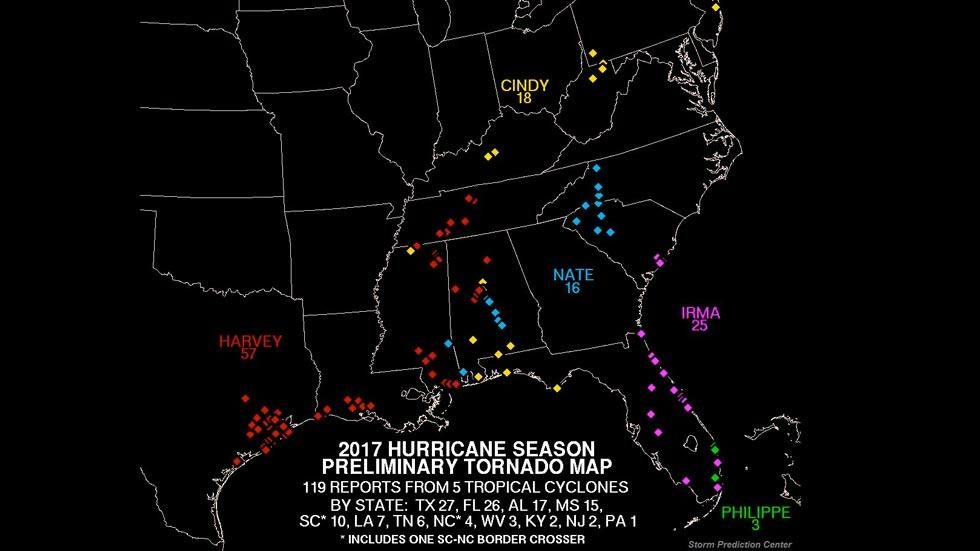
Five tropical cyclones were responsible for 119 reports of tornadoes in a dozen states, according to preliminary data provided by NOAA's Storm Prediction Center (SPC). This includes two tropical storms (Cindy and Philippe) and three hurricanes (Harvey, Irma and Nate).
Although Emily made landfall in Florida, and Jose and Maria brushed parts of the East Coast, there were no reported tornadoes from those three systems.
Hurricane Harvey had the largest number of tornado reports with 57, mostly clustered near the southeastern Texas coast, where devastating flooding occurred in the Houston metro area. Tornadoes were also spawned by Harvey as it weakened to a tropical storm and a tropical depression in Louisiana, Mississippi, Alabama and Tennessee.
Harvey's tornado reports account for 48 percent of the total 119 for all five tropical storms and hurricanes. Irma (25), Cindy (18), Nate (16) and Philippe (3) round out the other 52 percent of the reports.
When examined on a state level, Texas and Florida were neck-and-neck with 27 and 26 tornado reports, respectively. The main difference between those states is that Florida saw its tornado reports from three separate tropical cyclones (Cindy, Irma and Philippe), while all reports in Texas came solely from Harvey.
The only state in the Southeast that has not seen a reported tornado from a tropical cyclone in the 2017 hurricane season is Georgia. This is a contrast from what has been a record-setting tornado year in the Peach State, based on preliminary data.
2017 is now the fourth hurricane season since 1995 with tropical storms or hurricanes that produced more than 100 tornadoes. Only the 2005 (317), 2004 (238) and 2008 (139) hurricane seasons produced more tornadoes.
Most of the tornadoes associated with tropical cyclones develop in bands of thunderstorms and intense showers outside the eyewall about 50 to 250 miles from the hurricane or tropical storm center.
The majority of tornadoes spawned by tropical storms and hurricanes are short-lived and of the weaker EF0 or EF1 variety, but some can reach EF2 or EF3 intensity. Because of their short-lived nature, sometimes they can strike with little or no advance warning.
Hurricane Ivan in 2004 is the most prolific tornado-producing hurricane in U.S. weather history. A total of 120 tornadoes struck nine states from Florida to Pennsylvania in a three-day period.
But not all hurricanes generate a large number of tornadoes, as 2016's Hurricane Matthew illustrated. Matthew only produced two EF0-rated tornadoes since the eastern side of the hurricane, which is favored for tornado development, remained offshore.



Comment: See also: Study: Tornado outbreaks are increasing - but scientists don't understand why. A coauthor of this paper states "What's pushing this rise in extreme outbreaks is far from obvious in the present state of climate science."
Recently other climate scientists were saying hurricane Harvey "should serve as a warning", as they continue to push the man-made climate change/global warming lie. They are not considering the importance of atmospheric dust loading and the winning Electric Universe model in their research. Such information and much more, are explained in the book Earth Changes and the Human Cosmic Connection by Pierre Lescaudron and Laura Knight-Jadczyk. Increasing cometary and volcanic dust loading of the atmosphere (one indicator is the intensification of noctilucent clouds we are witnessing) is accentuating electric charge build-up, whereby we can expect to observe more extreme weather and planetary upheaval as well as awesome light shows and other related mysterious phenomena.